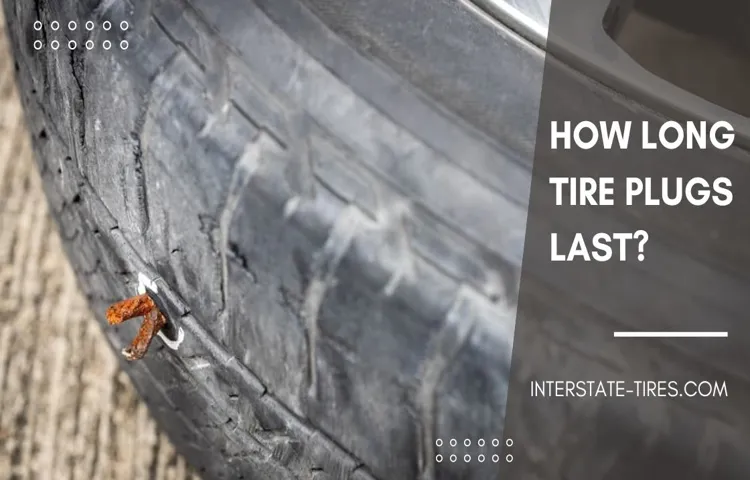Have you ever been driving down the road, only to hear a loud hissing sound coming from one of your tires? It can be a stressful situation, especially if you don’t have a spare with you. In some cases, a plugged tire can be a temporary fix to get you safely to a mechanic. But just how long can you rely on a plugged tire? Well, the answer is that it depends.
The lifespan of a plugged tire can vary depending on several factors, such as the size of the puncture, the location of the puncture, and how well the repair was done. In general, a properly plugged tire can last for many thousands of miles. But it’s important to keep in mind that a plugged tire is not a permanent solution – it’s always best to replace the tire as soon as possible for optimal safety.
Think of a plugged tire like a band-aid. It’s a quick fix that can help in a pinch, but it’s not a long-term solution. Just like how a band-aid eventually falls off, a plugged tire may eventually lose its seal and start leaking air again.
And just like how a cut may require stitches, a large or particularly dangerous puncture may require a completely new tire. Overall, a plugged tire can be a helpful temporary solution, but it’s important to prioritize safety and replace the tire as soon as possible. Don’t hesitate to consult a mechanic or tire specialist if you’re unsure whether your plugged tire is safe to continue using, as they can provide expert guidance and advice tailored to your specific situation.
Table of Contents
Overview
When it comes to tires, getting a puncture can be a real headache. But if you’ve had a tire plugged, you might be wondering how long it will last before you need a new one. In general, a properly plugged tire can last for as long as the tire itself would normally last.
However, it’s important to note that a plugged tire is not a permanent fix and should be addressed by a professional as soon as possible. The longer you drive on a plugged tire, the higher the risk of further damage or a tire blowout. It’s always best to err on the side of caution and have a plugged tire checked out by a trusted mechanic.
In the meantime, make sure to keep an eye on the tire’s pressure and avoid overloading or exceeding recommended speed limits. By taking these precautions, you’ll not only stay safe on the road but also extend the life of your tire.
Explanation of Tire Plugs
Tire plugs are a quick and easy fix to repair small punctures in your tire. These repairs are made by inserting a rubber plug into the puncture, sealing off the hole and preventing air loss. Tire plugs are a popular option for drivers because they are simple to use and can be done quickly, getting you back on the road in no time.
It is important to note, however, that tire plugs should only be used for punctures that are less than ¼ inch in diameter and are located in the tread of the tire. Plugs should not be used for large punctures or sidewall damage. By keeping tire plugs handy in your car, you can save yourself time and money in the event of a minor tire puncture.

Factors Affecting Lifespan of a Plugged Tire
Plugged tires are a common solution to fixing a flat tire, but many drivers wonder how long they can expect these repairs to last. There are several factors that can affect the lifespan of a plugged tire, including the type of plug used, the location of the puncture, and the overall condition of the tire. Choosing a high-quality plug and having it installed by a professional can help to extend the lifespan of a plugged tire.
Additionally, punctures in the sidewalls or in areas where the tire is flexed frequently may not be able to be plugged at all. It’s also important to regularly check the tire’s air pressure and have it inspected by a professional if there are signs of damage or wear. By taking care of your plugged tire and being mindful of these factors, you can maximize its lifespan and stay safe on the road.
Average Lifespan of a Plugged Tire
If you’re wondering how long a plugged tire will last, the answer is it can vary widely depending on several factors. First and foremost, the location and size of the puncture can greatly impact the lifespan of a plugged tire. If the hole is small and located in the center tread, your plugged tire may last for the remaining life of the tire.
However, if the puncture is on the sidewall or near the shoulder, the risk of failure increases. Additionally, the type of vehicle you drive and your driving habits can also affect the longevity of a plugged tire. If you frequently drive on rough or uneven surfaces, your plugged tire may be at higher risk for failure.
In general, it’s recommended to replace a tire that has been punctured and plugged after driving on it for 10,000 miles or if the tire has been in use for more than six years. Remember, whether or not a plugged tire lasts ultimately depends on the location and size of the puncture, driving habits, and the type of vehicle you drive.
Data on Average Lifespan of a Plugged Tire
The average lifespan of a plugged tire can vary depending on a few factors. Generally, a properly plugged tire should last as long as the remaining tread life of the tire. This means that if your tire has a lot of tread left, the plugged area shouldn’t cause any problems and you can drive normally without worrying about a blowout.
However, if your tire is already close to the end of its lifespan, plugging it might not be the best idea. It’s also important to note that the quality of the plug job can affect how long the tire lasts. If the plug is done correctly, using high-quality materials and with the proper tools, it should last just as long as the rest of the tire.
On the other hand, if the plug isn’t done well, it could come loose and cause a dangerous situation. Additionally, driving style can impact the lifespan of a plugged tire. Rough driving conditions, such as off-roading or driving on poorly maintained roads, can increase the wear and tear on the tire, including the plugged area.
Ultimately, it’s best to consult with a professional mechanic and follow their recommendations for how long a plugged tire should last in your specific situation.
Factors that Affect Lifespan of a Plugged Tire
When it comes to the lifespan of a plugged tire, several factors come into play. On average, a tire plug can last anywhere from a few months to a few years, depending on its placement and how well it was installed. However, it’s important to note that a plugged tire should never be considered a permanent solution.
The location of the puncture plays a crucial role in determining the lifespan of a plugged tire. If the puncture is near the sidewall or shoulder, it’s unlikely that the tire will last long as the flexing of the tire can cause the plug to fail. The diameter of the puncture can also affect the lifespan of a plugged tire – the larger the hole, the less likely it is that the plug will hold.
Additionally, how well the tire was installed, the age of the tire, and the type of tire also affect how long the plugged tire will last. Regular maintenance, including checking for leaks and monitoring the tire’s pressure, is vital to ensure your safety on the road. Remember, a plugged tire should be considered a temporary fix until a new tire can be installed.
Importance of Regular Maintenance and Inspection
Regular maintenance and inspection are crucial for the longevity of a vehicle and its components. Many drivers overlook the importance of checking their tires regularly, leading to potential safety risks and shorter lifespan of the tires. On average, a plugged tire can last anywhere from several days to one week, depending on the location and size of the puncture.
However, it is important to note that driving on a plugged tire is not recommended as it can compromise the tire’s structural integrity and lead to blowouts or even accidents on the road. Therefore, it is essential to inspect your tires regularly and make sure to replace any damaged or worn-out tires promptly. By doing so, you can save yourself from potential safety hazards and also extend the lifespan of your tires, ultimately saving you both time and money in the long run.
Signs that a Plugged Tire Needs Replacing
If your tire has been plugged to fix a puncture, you might be wondering how long it will last before it needs to be replaced. While a plugged tire can last for several years, you should always keep an eye out for signs of wear and tear. One of the most common signs that a plugged tire needs replacing is repeated flats.
If your tire keeps losing air despite having been plugged, it could be an indication that the patch job wasn’t done correctly or that the tire has become weakened and is more prone to punctures. Another sign to look out for is bulges or cracks in the tire’s sidewall. If the sidewall has been compromised by the puncture, it will become weaker and less able to support the weight of your car.
In this case, it’s best to replace the tire as soon as possible to avoid a blowout. In general, it’s always a good idea to have a professional inspect your tire after it has been plugged to ensure that it is safe for continued use on the road.
Indicators of Tire Damage and Wear
When it comes to tire damage and wear, it’s crucial to know when to replace a plugged tire. One indicator that a plugged tire needs replacing is if there is low pressure even after inflating the tire. Additionally, if the tire has been plugged multiple times, it may be time to consider a replacement.
Other signs of damage include visible punctures, bulges, or cracks on the tire. It’s essential to keep an eye out for these indicators as driving on a damaged tire can lead to a blowout or other dangerous situations. In summary, if a plugged tire is continuously losing pressure or has visible signs of wear, it’s time to consider a replacement.
It’s better to be proactive in these situations to ensure a safe and smooth driving experience.
When to Take a Plugged Tire to a Professional
Plugged Tire A plugged tire can be a worrying issue for every driver as it can pose a safety hazard while on the road. Knowing when to take a plugged tire to a professional is vital to keeping yourself and other motorists safe. One sign to look out for is if the tire loses air pressure regularly.
A plugged tire may hold initially but will eventually start to leak air, indicating that the plug has failed. In this case, it’s crucial to replace the tire before it completely goes flat or causes a blowout. Another sign is if the puncture is in the sidewall or shoulder area of the tire.
A plug may not hold in these areas, or the tire’s structural integrity may be compromised. It’s better to replace the tire entirely to avoid any potential dangers. Additionally, if you have a higher-end or expensive car, it’s better to have a professional handle the issue to ensure that the tire’s performance matches your vehicle’s standards.
Although it may be tempting to attempt to plug a tire yourself, it’s better to entrust the skill and experience of a professional tire technician. They can identify the issue and provide the necessary solution to get you back on the road safely.
Conclusion
In conclusion, a plugged tire can last for a varying amount of time depending on the size and location of the puncture. But, just like a temporary fix for any problem, it is only a matter of time before you need to address the root cause and invest in a more permanent solution. So, while a plugged tire may buy you some time, it’s best not to rely on it for too long and instead, replace or repair it as soon as possible.
Otherwise, you may find yourself stuck in a sticky situation when you least expect it!”
FAQs
Can a plugged tire last as long as a regular tire?
Yes, if the plug is installed correctly and the tire is not damaged in any other way.
How many miles can a plugged tire last?
It depends on the location and size of the puncture, as well as the quality of the repair. A properly plugged tire can last for thousands of miles.
Is it safe to drive on a plugged tire?
Yes, as long as the plug is installed correctly and the tire is not damaged in any other way. However, it is recommended to have the tire inspected by a professional as soon as possible.
Can a tire with multiple plugs still be safe to drive on?
It depends on the location and size of the punctures, as well as the quality of the repairs. Multiple plugs can weaken the tire and increase the risk of a blowout, so it’s best to have a professional inspect the tire.
Can a tire dealer refuse to repair a plugged tire?
Yes, if the tire is too damaged or the plug is not installed correctly. It’s important to always follow the manufacturer’s guidelines for tire repair.
Can a plugged tire be patched as well?
It depends on the location and size of the puncture. A professional tire repair person can determine if patching is also necessary.
Can a plugged tire be used as a spare tire?
Yes, as long as the plug is installed correctly and the tire is not damaged in any other way. However, it’s recommended to have a professional inspect the tire before using it as a spare.



